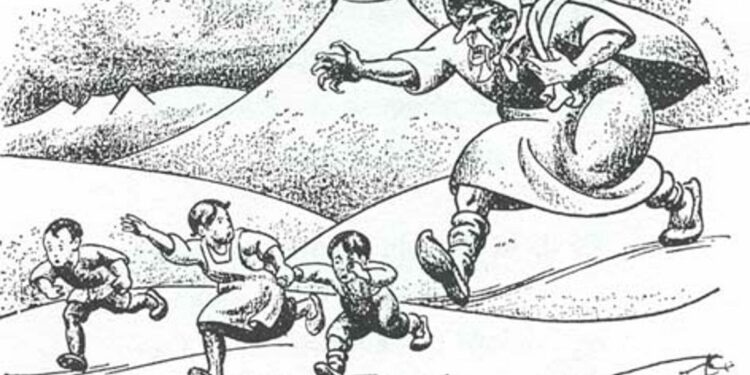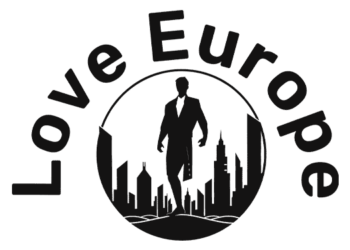Naughty children, however, get something unpleasant in their footwear.
Who are Iceland’s Yule Lads?
These mischievous tricksters all have unique names and personality traits, like Þvörusleikir the Spoon Licker; Pottaskeifill the Pot Licker; and Askasleikir the Bowl Licker (you can see a food-related pattern here!)
Some of the Yule Lads swipe sausages, gobble skyr, or skim the best froth from the top of the milk; and others slam doors, steal candles and peep in your windows.
While the Yule Lads are considered fairly harmless nowadays it’s their mother the troll witch Grýla who is truly terrifying – she’ll boil naughty children alive – there’s her lazy husband Leppalúði, and her evil black cat who prowls around Iceland and eats anyone not wearing a new piece of clothing at Christmas.
These homegrown Icelandic Christmas traditions have endured, even as Western Christmas ideals of a decorated pine tree, Santa Claus on his sleigh pulled by reindeer, and elves making toys have become firmly cemented in many other countries.
“We don’t have the American Santa Claus really,” explains Dagrún Ósk Jónsdóttir, a folklorist at the University of Iceland in Reykjavik.
“Many people are very proud of these Icelandic traditions and hold them very dear. It’s very visual as well, you have these events where the Yule Lads come, and on every milk carton in December you’ll see pictures of them” she says.
The evolution of Iceland’s modern Christmas traditions
Although the Yule Lads and their frightening family sound like they’re deeply rooted in Iceland’s past, they’re in fact a relatively new phenomenon in their present-day form.
The first written mention of Grýla appears in the 13th century but at that time she’s just a troll woman and doesn’t become connected with Christmas until the 17th century.
Meanwhile the modern version of Yule Lads only really start to crop up in written stories and poems in the 19th and 20th centuries, although they certainly existed much longer than that in oral storytelling traditions.
The number and nature of the Yule Lads have really only solidified in the last century and a half – before that they were much more sinister, dressed all in black, with more gruesome character traits too.
The Lung-Splatterer for example was said to have his lungs on the outside of his body and would run after misbehaving children and try to hit them with his floppy lungs.
As folklorist Dagrún Ósk Jónsdóttir explains, each parish had their own set of Yule Lads with their own traditions, but around 150 years ago an Icelandic poet picked the 13 which appealed to him the most and brought them together into one family unit with Grýla, her husband and the cat.
“It’s around the same time that the Yule Lads started making better traditions, they started giving kids presents, they weren’t the misbehaving thieves they were before,” she says.
“Before, people feared them, but now they’ve taken up better ways to a degree, even if they still steal food and slam doors and wake you up in the night!”
How Christmas traditions adapt even in the 21st century
All over Europe Christmas traditions have evolved through the centuries, but we can thank the Victorians for being responsible for shaping many of the most enduring Christmas images and activities.
ADVERTISEMENT
Queen Victoria’s husband Prince Albert is credited with bringing the tradition of decorating a Christmas tree to England in the 1840s – while in Southern Germany trees were being decorated already in the early 1600s – and Charles Dickens’ seminal story A Christmas Carol was first published in 1843.
The V&A Museum in London holds a collection of 30,000 greetings cards and notes that its founding director sent the first mass-produced card.
The Victorians also introduced winter scenes with robins, holly, and snow-covered landscapes, and invented the Christmas cracker, and the depiction of Santa Claus as a jolly old man with a white beard and red suit first became popular in the USA and Canada in the 1820s.
“It is right that folk traditions have to evolve and have relevance to society, otherwise they will just be forgotten,” says Dagrún Ósk Jónsdóttir.
And Icelanders are also seeing some changes to reflect modern-day values in their Christmas traditions, with Grýla’s cat becoming more environmentally conscious.
ADVERTISEMENT
“You’re supposed to buy a new item of clothing for the Christmas Cat or else he’ll eat you. But now with more sense of the dangers to the planet of mass consumption, he has also become this tool for advertising,” Dagrún Ósk Jónsdóttir explains.
“Now, the Yule Cat doesn’t mind if you get used clothing, as long as it’s new for you.”
Source link : https://www.euronews.com/2022/12/19/christmas-across-europe-iceland-s-festive-traditions-and-why-they-ve-stood-the-test-of-tim
Author :
Publish date : 2022-12-19 08:00:00
Copyright for syndicated content belongs to the linked Source.


